On Solutions of Linear Fractional Differential Equations with Uncertainty
Abstract
The solutions of linear fuzzy fractional differential equations (FFDEs) under the Caputo differentiability have been investigated. To this end, the fuzzy Laplace transform was used to obtain the solutions of FFDEs. Then, some new results regarding the relation between some types of differentiability have been obtained. Finally, some applicable examples are solved in order to show the ability of the proposed method.
1. Introduction
The topic of fuzzy differential equations (FDEs) has been rapidly growing in recent years (see, e.g., [1–8] and the references therein). Recently, applying fractional differential equations has grown increasingly and have excited as a considerable interest both in mathematics and applications, such that they were used in modeling of many physical and chemical processes and in engineering [9–15].
In addition, many research papers are published to consider solutions of fractional differential equations (see, e.g., [16–18] and the references therein).
Recently, Agarwal et al. [19] proposed the concept of solutions for fractional differential equations with uncertainty. They considered the Riemann-Liouville differentiability to solve FFDEs which is a combination of Hukuhara difference and Riemann-Liouville derivative. There are some basic papers which are written by Bede and Gal [20] who discussed on shortcomings of applications of Hukuhara difference. So, we adopt a generalization of a strongly generalized differentiability to a fractional case.
In the following, we propose the Riemann-Liouville differentiability by using Hukuhara difference which is named as the Riemann-Liouville H-differentiability. Therefore, a direct procedure is adopted to derive such concept which is constructed based on the combination of strongly generalized differentiability [21] and the Riemann-Liouville derivative [14, 15]. Moreover, we suggest the concept of fractional derivatives under Caputo’s differentiability by applying the Hukuhara difference which is named as Caputo’s H-differentiability. Similar to the deterministic cases, construction of Caputo’s derivatives is based on the definitions of the Riemann-Liouville derivatives in fuzzy cases.
Consequently, we intend to propose an analytical method to solve FFDEs. Since, considering solutions of FFDEs is a new subject, presets the fractional Green’s functions for fuzzy fractional differential equations is considered and, as particular cases, we obtain the classical harmonic oscillator, the damped harmonic oscillator, relaxation equation, all in the fuzzy fractional versions by using fuzzy laplace transforms; so we should first implement analytical method to solve it; then numerical methods can be applied. To this end, we adopt fractional Green’s functions to solve FFDEs by using fuzzy Laplace transforms method. One can see some useful papers about fuzzy Laplace transforms in [2, 22, 23].
Recently, Salahshour et al. proposed some new results toward existence and uniqueness of the solutions of FFDE [24]. Then, Mazandarani and Kamyad numerically solved the FFDE using the Euler method [25]. Also, Agarwal et al. [26] investigated fuzzy fractional integral equation under compactness type condition.
This paper is structured as follows. In Section 1, we recall some well-known definitions of fuzzy numbers and present some needed concepts. In Section 2, Caputo’s H-differentiability is introduced, and the relation between the Riemann-Liouville differentiability and Caputo’s H-differentiability and some of their properties is considered. Consequently, the fuzzy Laplace transforms are considered for fuzzy-valued function, and an essential theorem for the Laplace transform of f under Caputo’s H-derivative is given in Section 3. The solutions of FFDEs are investigated by using the fuzzy Laplace transforms and their inverses in Section 4. In Section 5, some examples are solved to illustrate the method. Finally, conclusion is drawn in Section 6.
2. Preliminaries
The basic definition of fuzzy numbers can be seen in [27].
- (a)
u is upper semicontinuous.
- (b)
u is fuzzy convex; that is, u(λx + (1 − λ)y) ≥ min {u(x), u(y)} for all x, y ∈ ℝ, λ ∈ [0,1].
- (c)
u is normal; that is; ∃x0 ∈ ℝ for which u(x0) = 1.
- (d)
supp u = {x ∈ ℝ∣u(x) > 0} is the support of the u, and its closure cl (supp u) is compact.
An equivalent parametric definition is also given in [28–30] as follows.
Definition 1. A fuzzy number u in parametric form is a pair of functions , , 0 ≤ r ≤ 1, which satisfy the following requirements:
- (1)
is a bounded nondecreasing left continuous function in (0,1]; and right continuous at 0;
- (2)
is a bounded nonincreasing left continuous function in (0,1]; and right continuous at 0;
- (3)
, 0 ≤ r ≤ 1.
Moreover, we also can present the r-cut representation of fuzzy number as for all 0 ≤ r ≤ 1.
- (1)
d(u + w, v + w) = d(u, v), for all u, v, w ∈ 𝔼,
- (2)
d(ku, kv) = |k|d(u, v), for all k ∈ ℝ, u, v ∈ 𝔼,
- (3)
d(u + v, w + e) ≤ d(u, w) + d(v, e), for all u, v, w, e ∈ 𝔼,
- (4)
(d, 𝔼) is a complete metric space.
Theorem 2 (see [32].)Let f(x) be a fuzzy-valued function on [a, ∞), and it is represented by . For any fixed r ∈ [0,1], assume that and are Riemann-integrable on [a, b] for every b ≥ a, and assume that there are two positive and such that and for every b ≥ a. Then f(x) is improper fuzzy Riemann-integrable on [a, ∞), and the improper fuzzy Riemann-integral is a fuzzy number. Furthermore, one has:
Definition 3. Let x, y ∈ 𝔼. If there exists z ∈ 𝔼 such that x = y + z, then z is called the H-difference of x and y, and it is denoted by x ⊖ y.
In this paper, the sign “⊖” always stands for H-difference, and also note that x ⊖ y ≠ x + (−1)y.
2.1. Caputo’s H-Differentiability
In this section, the concept of the fuzzy Caputo derivatives has been reviewed [33–35]. Also, we denote by C𝔽[a, b] a space of all fuzzy-valued functions which are continuous on [a, b]. Also, we denote the space of all Lebesgue integrable fuzzy-value functions on the bounded interval [a, b] ⊂ ℝ by L𝔽[a, b], and we denote the space of fuzzy-value functions f(x) which have continuous H-derivative up to order n − 1 on [a, b] such that f(n−1)(x) ∈ AC𝔽([a, b]) by AC(n)𝔽([a, b]).
Definition 4. Let f ∈ C𝔽[a, b]∩L𝔽[a, b]; the fuzzy Riemann-Liouville integral of fuzzy-valued function f is defined as follows:
Since , for all 0 ≤ r ≤ 1, then one can indicate the fuzzy Riemann-Liouville integral of fuzzy-valued function f based on the lower and upper functions as follows.
Theorem 5. Let f(x) ∈ C𝔽[a, b]∩L𝔽[a, b]; the fuzzy Riemann-Liouville integral of fuzzy-valued function f is defined by
Now, we define the fuzzy Riemann-Liouville fractional derivatives of order n − 1 < β < n for fuzzy-valued function f (which is a direct extension of strongly generalized H-differentiability [20] and lateral type of H-differentiability [36] in the fractional literature) as follows.
Definition 6. Let , let x0 ∈ (a, b), and let Φ(x) = (1//(x − t) β−n+1) (n = [β] + 1; x > a). We say that f is fuzzy Riemann-Liouville fractional differentiable of order β, at x0, if there exists an element , such that for all h > 0 sufficiently small
For sake of simplicity, we say that a fuzzy-valued function f is RL[(i) − β]-differentiable if it is differentiable as in Definition 6 case (i) and is RL[(ii) − β]-differentiable if it is differentiable as in Definition 6 case (ii).
Theorem 7. Let f(x) ∈ C(n)𝔽[a, b]∩L𝔽[a, b], x0 ∈ (a, b), (β > 0), and (n = [β] + 1) such that for all 0 ≤ r ≤ 1, then
(i) if f(x) is a RL[(i) − β]-differentiable fuzzy-valued function, then
(ii) if f(x) is a RL[(ii) − β]-differentiable fuzzy-valued function, then
Definition 8. Let , and f(n) is integrable; then the right fuzzy Caputo derivative of f for n − 1 < β < n and x ∈ [a, b] is denoted by and defined by
Theorem 9. Let f(x) ∈ C(n)𝔽[a, b]∩L𝔽[a, b], x ∈ (a, b), and n − 1 < β < n, such that for all 0 ≤ r ≤ 1, then
(i) if f is a C[(i) − β]-differentiable fuzzy-valued function, then
(ii) if f(x) is a C[(ii) − β]-differentiable fuzzy-valued function, then
Proof. We prove the case of C[(i) − β]-differentiability, (β) > 0, (n = [β] + 1), and for the case of C[(ii) − β]-differentiability the proof is completely similar to previous one, and hence it is omitted.
Let us consider that f is C[(i) − β]-differentiability and that x ∈ (a, b); then we have the following:
Similarly, we get the following:
Passing to the limit we obtain
3. The Fuzzy Laplace Transforms
In this section, we consider the fuzzy Laplace transform for fuzzy-valued function; then derivative theorem is given which is essential to determine solutions of FFDEs.
In this way, Allahviranloo and Ahmadi [2] suggested the concept of Laplace transforms for fuzzy-valued function as follows.
Definition 10 (see [2].)Let f(x) be continuous fuzzy-value function. Suppose that f(x)⊙e−px is improper fuzzy Riemann-integrable on [0, ∞); then is called fuzzy Laplace transforms and is denoted by
Remark 11. In [8], the authors have investigated under what conditions the fuzzy-valued functions can possess the fuzzy Laplace transform. So, we suppose that the given fuzzy-valued functions have mentioned conditions throughout the paper.
Theorem 12 (see [2].)Let f(x), g(x) be continuous-fuzzy-valued functions; suppose that c1, c2 are constant; then
Lemma 13 (see [2].)Let f(x) be continuous fuzzy-value function on [0, ∞) and let λ ∈ ℝ; then
Lemma 14 (see [2].)Let f(x) be continuous fuzzy-value function and g(x) ≥ 0. Suppose that (f(x)⊙g(x))⊙e−px is improper fuzzy Riemann-integrable on [0, ∞); then
Theorem 15 (first translation theorem (see [2].)Let f be continuous fuzzy value function and let L[f(x)] = F(p). Then
In order to solve FFDEs, it is necessary to know the fuzzy Laplace transform of Caputo’s H-derivative of f, . The virtue of is that it can be written in terms of L[f(x)].
Theorem 16 (derivative theorem). Suppose that f(x) ∈ C(n)𝔽[0, ∞)∩L𝔽[0, ∞); then
Proof. For arbitrary fixed r ∈ [0,1] we have
4. Fractional Green’s Functions
4.1. Determining Algebraic Solutions
Case I. Let us consider that DΦ(x) is a C[(i) − β]-differentiable function; then (43) is extended based on the its lower and upper functions as follows:
Case II. Let us consider that DΦ(x) is C[(ii) − β]-differentiable; then (43) can be written as follows:
5. Examples
In this section, we consider several examples, and we find explicit expressions for fractional Green’s functions, including some versions of the fuzzy harmonic oscillator equations and fuzzy relaxation equation under Caputo’s H-differentiability.
Example 1 (Green’s function for fuzzy damped harmonic oscillator). Let us examine the following FFDE:
Case I. Suppose that λ ∈ ℝ+ = (0, ∞); then taking Laplace transform on the both sides of above equation, we have
Case II. If λ ∈ ℝ− = (−∞, 0), then by using C[(ii) − β]-differentiability and Theorem 16, and their inverses, fractional Green’s function will be obtained similar to (60).
Example 2 (Green’s function for fuzzy the driven harmonic oscillator). Let us investigate the following FFDEs; namely,
with b = 0 and 1/2 < β < 1; the fuzzy fractional differential equation associated with the driven harmonic oscillator is obtained. We obtain the same result taking b = 0, a = 1 and solve this example according to the two following cases for λ ∈ ℝ.
Case I. Suppose that λ ∈ ℝ+ = (0, +∞); then taking Laplace transform on the both sides of above equation, we have the following:
Case II. Let us suppose that λ ∈ ℝ− = (−∞, 0); then using C[(ii) − β]-differentiability and Theorem 16 and their inverses, fractional Green’s function will be obtained similar to (68).
Example 3 (Green’s functions for fuzzy fractional relaxation equation). The next step is to consider the following FFDE:
Case I. Suppose that λ ∈ ℝ+ = (0, +∞); then taking Laplace transform on the both sides of above equation, we have
Case II. Suppose that λ ∈ ℝ− = (−∞, 0); then using C[(ii) − β]-differentiability and Theorem 16, and their inverses, fractional Green’s function will be obtained similar to (78).
Now, we provide some examples such that the obtained solutions coincide with the previously reported solution in integer case [37].
Example 4. For a special case, let us consider the following FFDE:
Case I. Suppose that λ ∈ ℝ+ = (0, +∞); then using C[(i) − β]-differentiability and Theorem 16, the solution is derived as follows:
Case II. Suppose that λ ∈ ℝ− = (−∞, 0); then using C[(ii) − β]-differentiability and Theorem 16, the solution will be obtained similar to (83). For more details see Figures 1, 2, 3, and 4.
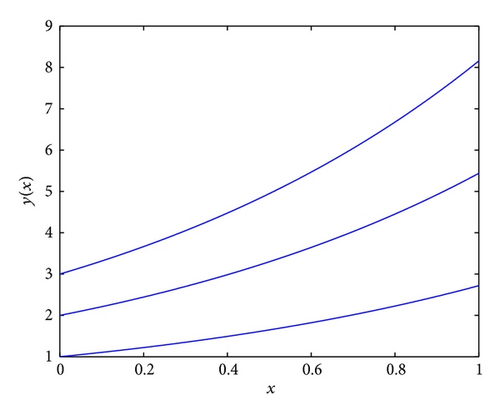
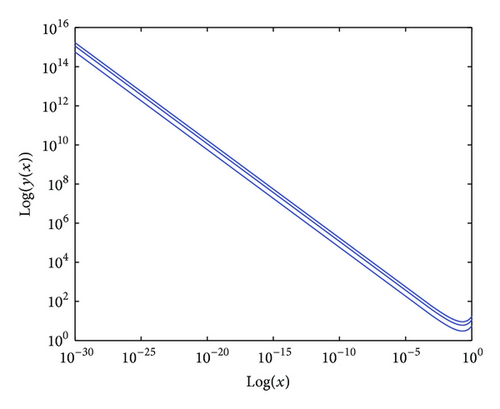
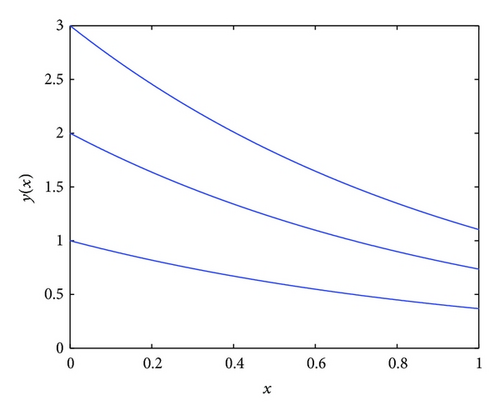
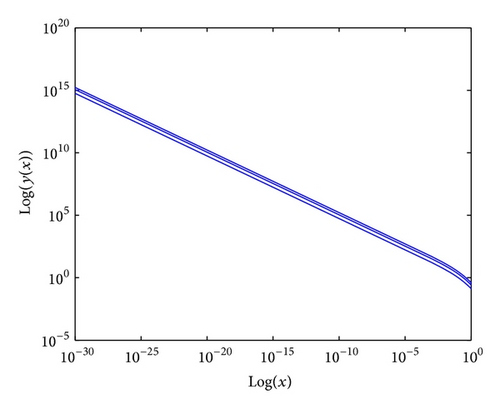
Example 5. Let us discuss the following FFDE:
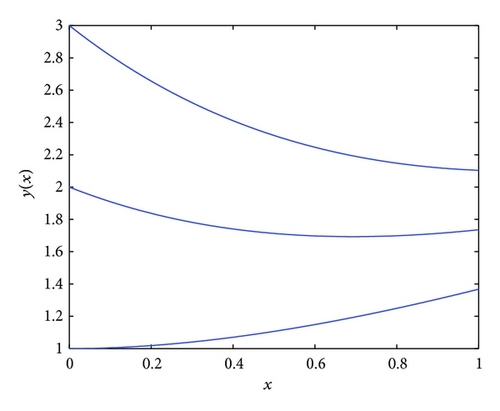
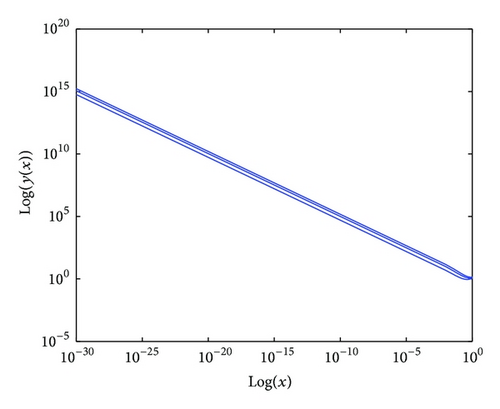
6. Conclusion
In this paper, the fractional Green’s functions for the solutions of FFDEs by using the fuzzy Laplace transforms under Caputo’s differentiability were applied. Some particular cases were also presented, involving some fuzzy versions of the harmonic oscillator. To this end, some needed concepts are given like the Caputo derivatives, fuzzy Laplace transforms, and their inverses, and so forth. For future research, we extend the boundary value problem for FDE [38] to the fractional case.
Acknowledgments
The authors thank the referees for careful reading and helpful suggestions on the improvement of the paper.




